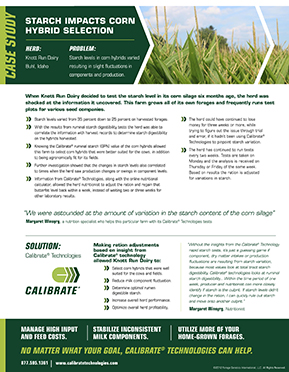Download PDF

When Knott Run Dairy decided to test the starch level in its corn silage six months ago, the herd was shocked at the information it uncovered. This farm grows all of its own forages and frequently runs test plots for various seed companies.
- Starch levels varied from 35 percent down to 25 percent on harvested forages
- With the results from starch digestibility tests the herd was able to correlate the information with harvest records to determine starch digestibility on the hybrids harvested.
- Knowing the Calibrate® ruminal starch GPN value of the corn hybrids allowed this farm to select corn hybrids that were better suited for the cows, in addition to being agronomically fit for its fields.
“We were astounded at the amount of variation in the starch content of the corn silage,” says Margaret Winsyrg, a nutrition specialist who helps this particular farm with its Calibrate® Technologies tests.
- Further investigation showed that the changes in starch levels also correlated to times when the herd saw production changes or swings in component levels.
- At one point the herd lost .10 percent of butterfat, dropping from a 3.70 percent to a 3.60 percent. Information from Calibrate® Technologies, along with the online nutritional calculator, allowed the herd nutritionist to adjust the ration and regain that butterfat level back within a week, instead of waiting two or three weeks for other laboratory results
- The herd could have continued to lose money for three weeks or more, while trying to figure out the issue through trial and error, if it hadn’t been using Calibrate® Technologies to pinpoint starch variation.
- The herd has continued to run tests every two weeks. Tests are taken on Monday and the analysis is received on Thursday or Friday of the same week. Based on results the ration is adjusted for variations in starch.
“Without the insights from the Calibrate® Technology rapid starch tests, it’s just a guessing game if component, dry matter intakes or production fluctuations are resulting from starch variation, because most values look at total tract starch digestibility, Calibrate® technologies looks at ruminal starch digestibility,” says Winsyrg. “Within the time period of one week, producer and nutritionist can more closely identify if starch is the culprit. If starch levels didn’t change in the ration, I can quickly rule out starch and move onto another culprit.”